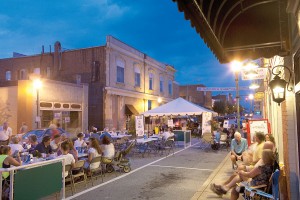Drive 133 miles northwest, about 2.5 hours, to Seneca, and turn back the hands of time. “Seneca” comes from an Indian village that stood nearby. Aged rocks and timeless waterfalls create a region where the past never dies. Not only is the northwest corner old geologically, it’s historical, and you can visit old places preserved much as they were. One exception is an alley that turned into a popular attraction.
To see this one-time unsavory alley reinvented as a cool pedestrian-friendly spot, go to Seneca’s Ram Cat Alley. The lyrics of that Led Zeppelin tune sum up its history: “Good times, bad times, you know I had my share.” If you could go back to the early 1900s, you’d find the bad times of pool halls, bars and cat-luring fish and meat markets. So many hungry cats congregated in the alley that some wag said, “You couldn’t ram another cat into the alley.” Ram Cat Alley, thus, had its colorful name. In time, the alley fell into neglect.
In the mid-1990s, good times arrived. Revitalization turned this one-time alleyway of pool halls, bars and meat markets into a walk-about place of boutique shops and restaurants. It’s lively. On Thursdays, restaurants and the city set up tables for “Jazz On the Alley.” From disrepute to being on the National Register of Historic Places and jazzy: that’s how far Ram Cat Alley has come.
Seneca and Oconee County offer day travelers many ways to visit the past. Stumphouse Tunnel revives frustrated dreams of train commerce to the West, and Isaqueena Falls reveals shimmering veils of water that have long blessed the area with beauty. Not far away, Oconee Station and its beautiful fieldstone building served as protection against the Cherokee, a trading post and a storage place for furs.
Step back in time at Keil Farm and see an antebellum farmhouse that changed from the mid-19th to early 20th century. By 1905, the circa 1850 farmhouse had evolved from a two-room house, kitchen and loft building to a seven-room house. Today, the farm consists of a one-and-one-half story frame farmhouse and rustic outbuildings that completed farm life: a barn, corncrib, chicken house, smoke house, tenant house and outhouse.
Add the Newry Historic District to your itinerary. See what a textile mill village looked like. Most of the buildings in Newry arose from 1893 to 1910 and illustrate a turn-of-the century mill village in South Carolina.
Plan a trip to Seneca and Oconee County in general where the National Register of Historic Places works overtime. Soon the mountains and valleys will green up as spring brings its warmer days. It’s as good a time as any to visit the past. And at revitalized Ram Cat Alley you’ll be hard pressed to conjure up images of frantic felines looking for a meal. After a day of sightseeing, you’ll be the one with dinner on your mind.
If You Go …
For information on Seneca:
www.oconeecountry.com/seneca.html
For other historic sites: www.nationalregister.sc.gov/oconee/S10817737014/index.htm
Learn more about Tom Poland, a Southern writer, and his work at www.tompoland.net. Email day-trip ideas to him at [email protected].













